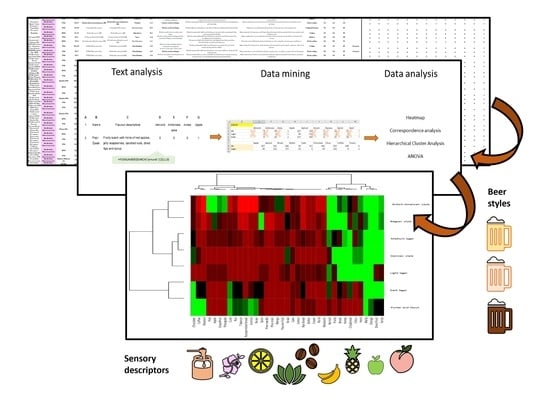Mapping the Sensory Fingerprint of Swedish Beer Market through Text and Data Mining and Multivariate Strategies
Abstract
1. Introduction
2. Materials and Methods
2.1. Data Capture, Standardisation, and Data Mining
2.2. Data Analysis
3. Results and Discussion
3.1. General Overview of the Swedish Market
3.2. Sensory Fingerprint of Swedish Beers
3.2.1. Lexicon of Swedish Beers
3.2.2. Sensory Characterization
Ale Beers
Lager Beers
3.3. Text Data as a Tool for Hop Characterization
4. Conclusions
Supplementary Materials
Author Contributions
Funding
Institutional Review Board Statement
Informed Consent Statement
Data Availability Statement
Conflicts of Interest
References
- Parker, D.K. Beer: Production, Sensory Characteristics and Sensory Analysis; Woodhead Publishing Limited: Sawston, UK, 2012. [Google Scholar]
- Bettenhausen, H.M.; Barr, L.; Broeckling, C.D.; Chaparro, J.M.; Holbrook, C.; Sedin, D.; Heuberger, A.L. Influence of malt source on beer chemistry, flavor, and flavor stability. Food Res. Int. 2018, 113, 487–504. [Google Scholar] [CrossRef]
- Moir, M.; Moir, M.; Courage, S.; Limited, B. The Science of Beer Hops—A Millennium Review Hops—A Millennium Review. J. Am. Soc. Brew. Chem. 2018, 58, 131–146. [Google Scholar] [CrossRef]
- Goiris, K.; Jaskula-Goiris, B.; Syryn, E.; Van Opstaele, F.; De Rouck, G.; Aerts, G.; De Cooman, L. The flavoring potential of hop polyphenols in beer. J. Am. Soc. Brew. Chem. 2014, 72, 135–142. [Google Scholar] [CrossRef]
- Mozzon, M.; Foligni, R.; Mannozzi, C. Brewing Quality of Hop Varieties Cultivated in Central Italy Based on Multivolatile Fingerprinting and Bitter Acid Content. Foods 2020, 9, 541. [Google Scholar] [CrossRef]
- Arranz, S.; Chiva-Blanch, G.; Valderas-Martínez, P.; Medina-Remón, A.; Lamuela-Raventós, R.M.; Estruch, R. Wine, beer, alcohol and polyphenols on cardiovascular disease and cancer. Nutrients 2012, 4, 759–781. [Google Scholar] [CrossRef] [PubMed]
- Krebs, G.; Gastl, M.; Becker, T. Chemometric modeling of palate fullness in lager beers. Food Chem. 2021, 342, 128253. [Google Scholar] [CrossRef] [PubMed]
- Meilgaard, M.C. Prediction of Flavor Differences between Beers from Their Chemical Composition. J. Agric. Food Chem. 1982, 30, 1009–1017. [Google Scholar] [CrossRef]
- Lafontaine, S.R.; Shellhammer, T.H. Investigating the Factors Impacting Aroma, Flavor, and Stability in Dry-Hopped Beers. Tech. Q. 2019, 56, 13–23. [Google Scholar] [CrossRef]
- Štefániková, J.; Nagyová, V.; Hynšt, M.; Kudláková, D.; Árvay, J.; Dráb, Š. A comparison of sensory evaluation and an electronic nose assay in the assessment of aroma in dry hopped beers. Kvas. Prum. 2020, 66, 224–231. [Google Scholar] [CrossRef]
- Nickerson, G.B.; Van Engel, E.L.; Nickerson, G.B.; Chemistry, A. Hop Aroma Component Profile and the Aroma Unit. J. Am. Soc. Brew. Chem. 1992, 50, 77–81. [Google Scholar] [CrossRef]
- Takoi, K.; Degueil, M.; Shinkaruk, S.; Thibon, C.; Maeda, K.; Ito, K.; Bennetau, B.; Dubourdieu, D.; Tominaga, T. Identification and characteristics of new volatile thiols derived from the hop (Humulus luplus L.) cultivar nelson Sauvin. J. Agric. Food Chem. 2009, 57, 2493–2502. [Google Scholar] [CrossRef]
- Gonzalez Viejo, C.; Fuentes, S.; Torrico, D.D.; Godbole, A.; Dunshea, F.R. Chemical characterization of aromas in beer and their effect on consumers liking. Food Chem. 2019, 293, 479–485. [Google Scholar] [CrossRef] [PubMed]
- Silva, A.P.; Jager, G.; Van Zyl, H.; Voss, H.-P.; Pintado, M.; Hogg, T.; De Graaf, C. Cheers, proost, saúde: Cultural, contextual and psychological factors of wine and beer consumption in Portugal and in The Netherlands. Crit. Rev. Food Sci. Nutr. 2017, 57, 1340–1349. [Google Scholar] [CrossRef]
- De Brito, S.A.; Baldykowski, A.L.; Miczevski, S.A.; Silva, T.H. Cheers to untappd! preferences for beer reflect cultural differences around the world. In Proceedings of the Twenty-fourth Americas Conference on Information Systems, New Orleans, LA, USA, 16–18 August 2018. [Google Scholar]
- Van Doorn, G.; Watson, S.; Timora, J.; Spence, C. The influence of training and expertise on the multisensory perception of beer: A review. Food Qual. Prefer. 2020, 79, 103778. [Google Scholar] [CrossRef]
- Meilgaard, M.C.; Dalgliesh, C.E.; Clapperton, J.F. Beer Flavour Terminology. J. Inst. Brew. 1979, 85, 38–42. [Google Scholar] [CrossRef]
- Schmelzle, A. The beer aroma wheel: Updating beer flavour terminology according to sensory standards. Brew. Sci. 2009, 62, 26–32. [Google Scholar]
- Lelièvre, M.; Chollet, S.; Abdi, H.; Valentin, D. What is the validity of the sorting task for describing beers? A study using trained and untrained assessors. Food Qual. Prefer. 2008, 19, 697–703. [Google Scholar] [CrossRef]
- Chollet, S.; Lelièvre, M.; Abdi, H.; Valentin, D. Sort and beer: Everything you wanted to know about the sorting task but did not dare to ask. Food Qual. Prefer. 2011, 22, 507–520. [Google Scholar] [CrossRef]
- Reinbach, H.C.; Giacalone, D.; Ribeiro, L.M.; Bredie, W.L.P.; Frøst, M.B. Comparison of three sensory profiling methods based on consumer perception: CATA, CATA with intensity and Napping®. Food Qual. Prefer. 2014, 32, 160–166. [Google Scholar] [CrossRef]
- Romero-Medina, A.; Estarrón-Espinosa, M.; Verde-Calvo, J.R.; Lelièvre-Desmas, M.; Escalona-Buendiá, H.B. Renewing Traditions: A Sensory and Chemical Characterisation of Mexican Pigmented Corn Beers. Foods 2020, 9, 886. [Google Scholar] [CrossRef]
- Liu, C.; Dong, J.; Wang, J.; Yin, X.; Li, Q. A comprehensive sensory evaluation of beers from the Chinese market. J. Inst. Brew. 2012, 118, 325–333. [Google Scholar] [CrossRef]
- Donadini, G.; Fumi, M.D.; de Faveri, D.M. Sensory characteristics of Romanian, Polish, Albanian and former yugoslavian beers. J. Inst. Brew. 2011, 117, 507–515. [Google Scholar] [CrossRef]
- Blanco, C.; Nimubona, D.; Fernández-Fernández, E.; Álvarez, I. Sensory Characterization of Commercial Lager Beers and Their Correlations with Iso-α-Acid Concentrations. J. Food Nutr. Res. 2014, 3, 1–8. [Google Scholar] [CrossRef][Green Version]
- Giacalone, D.; Ribeiro, L.M.; Frøst, M.B. Consumer-Based Product Profiling: Application of Partial Napping® for Sensory Characterization of Specialty Beers by Novices and Experts. J. Food Prod. Mark. 2013, 19, 201–218. [Google Scholar] [CrossRef]
- Kruger, M.; Brand, J.; Watson, B.; Buica, A. Exploring an automated attribute consolidation approach: A case study on craft gins and beers. In Proceedings of the 14th Pangborn Sensory Science Symposium, 9–12 August 2021. [Google Scholar]
- Valente, C.C.; Bauer, F.F.; Venter, F.; Watson, B.; Nieuwoudt, H.H. Modelling the sensory space of varietal wines: Mining of large, unstructured text data and visualisation of style patterns. Sci. Rep. 2018, 8, 1–13. [Google Scholar] [CrossRef] [PubMed]
- Da Silva, T.M.; Marinoni, D.T.; Peano, C.; Giuggioli, N.R. A new sensory approach combined with a text-mining tool to create a sensory lexicon and profile of monovarietal apple juices. Foods 2019, 8, 608. [Google Scholar] [CrossRef] [PubMed]
- Anzanello, M.J.; Fogliatto, F.S.; Rossini, K. Data mining-based method for identifying discriminant attributes in sensory profiling. Food Qual. Prefer. 2011, 22, 139–148. [Google Scholar] [CrossRef]
- Valente, C.C. Understanding South African Chenin Blanc Wine by Using Data Mining Techniques Applied to Published Sensory Data. Ph.D. Thesis, Stellenbosch University, Stellenbosch, South Africa, 2016. [Google Scholar]
- Mafata, M. A Chemometric Approach to Investigating South African Wine Behaviour Using Chemical and Sensory Markers. Ph.D. Thesis, Stellenbosch University, Stellenbosch, South Africa, 2021. [Google Scholar]
- Koren, D.; Lőrincz, L.; Kovács, S.; Kun-Farkas, G.; Vecseriné Hegyes, B.; Sipos, L. Comparison of supervised learning statistical methods for classifying commercial beers and identifying patterns. J. Chemom. 2020, 34, e3216. [Google Scholar] [CrossRef]
- Systembolaget. Available online: https://www.systembolaget.se/ (accessed on 3 April 2020).
- Humia, B.V.; Santos, K.S.; Barbosa, A.M.; Sawata, M.; Mendonça, M.D.C.; Padilha, F.F. Beer molecules and its sensory and biological properties: A review. Molecules 2019, 24, 1568. [Google Scholar] [CrossRef]
- Verstrepen, K.J.; Derdelinckx, G.; Dufour, J.; Winderickx, J.; Thevelein, J.M.; Pretorius, I.S.; Delvaux, F.R.; Box, P.O.; Osmond, G.; Sa, A. Flavor-active-esters-Adding-fruitiness-to-beer_2003_Journal-of-Bioscience-and-Bioengineering. J. Biosci. Bioeng. 2003, 96, 110–118. [Google Scholar] [CrossRef]
- Takoi, K.; Itoga, Y.; Koie, K.; Kosugi, T.; Shimase, M.; Katayama, Y.; Nakayama, Y.; Watari, J. The contribution of geraniol metabolism to the citrus flavour of beer: Synergy of geraniol and β-citronellol under coexistence with excess linalool. J. Inst. Brew. 2010, 116, 251–260. [Google Scholar] [CrossRef]
- Takoi, K.; Itoga, Y.; Koie, K.; Takayanagi, J.; Kaneko, T.; Watanabe, T.; Matsumoto, I.; Nomura, M. Systematic analysis of behaviour of hop-derived monoterpene alcohols during fermentation and new classification of geraniol-rich flavour hops. Brew. Sci. 2017, 70, 177–186. [Google Scholar] [CrossRef]
- Gros, J.; Peeters, F.; Collin, S. Occurrence of Odorant Polyfunctional Thiols in Beers Hopped with Different Cultivars. First Evidence of an S-Cysteine Conjugate in Hop (Humulus lupulus L.). J. Agric. Food Chem. 2012, 60, 7805–7816. [Google Scholar] [CrossRef]
- Brand, J.; Panzeri, V.; Buica, A. Wine Quality Drivers: A Case Study on South African Chenin Blanc and Pinotage Wines. Foods 2020, 9, 805. [Google Scholar] [CrossRef] [PubMed]
- Jardim, C.D.C.; De Souza, D.; Machado, I.C.K.; Pinto, L.M.N.; Ramos, R.C.D.S.; Garavaglia, J. Sensory Profile, Consumer Preference and Chemical Composition of Craft Beers from Brazil. Beverages 2018, 4, 106. [Google Scholar] [CrossRef]
- Hopfer, H.; McDowell, E.H.; Nielsen, L.E.; Hayes, J.E. Preferred beer styles influence both perceptual maps and semantic descriptions of dry hops. Food Qual. Prefer. 2021, 94, 104337. [Google Scholar] [CrossRef]
- Kankolongo Cibaka, M.L.; Ferreira, C.S.; Decourrière, L.; Lorenzo-Alonso, C.J.; Bodart, E.; Collin, S. Dry hopping with the dual-purpose varieties Amarillo, Citra, Hallertau Blanc, Mosaic, and Sorachi ace: Minor contribution of hop terpenol glucosides to beer flavors. J. Am. Soc. Brew. Chem. 2017, 75, 122–129. [Google Scholar] [CrossRef]
- Barthhaas. Hop Harvest Guide 2020; Barthhaas: Nürnberg, Germany, 2020. [Google Scholar]
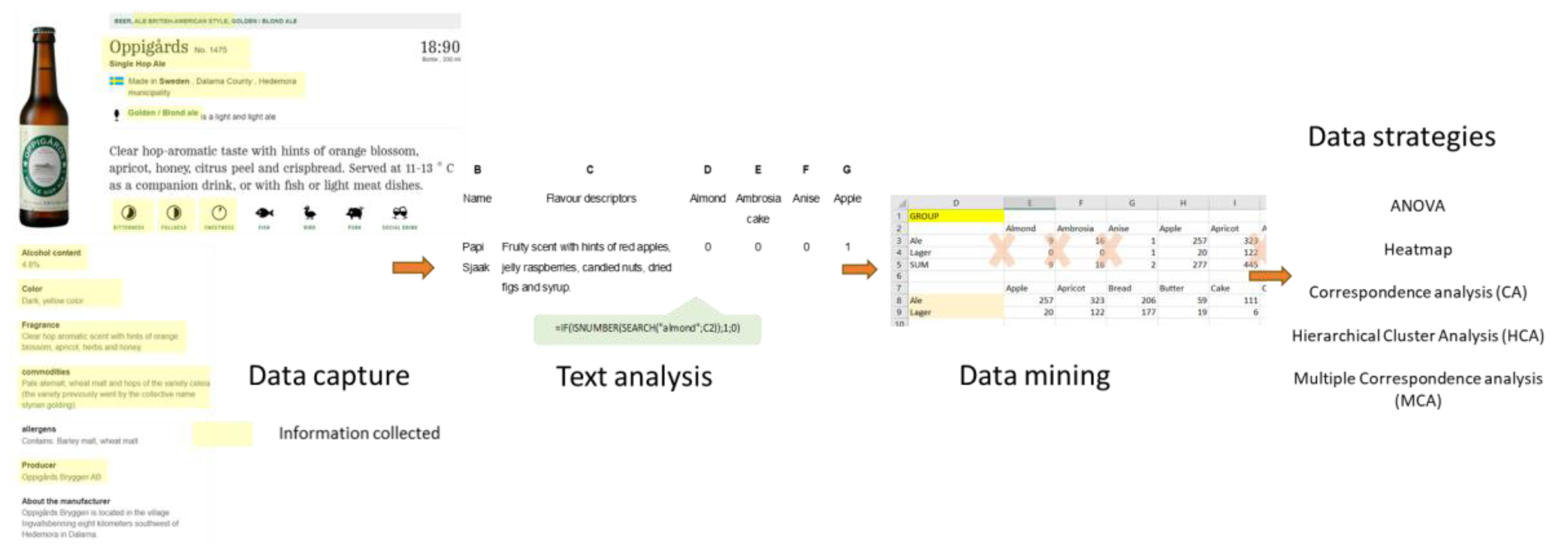
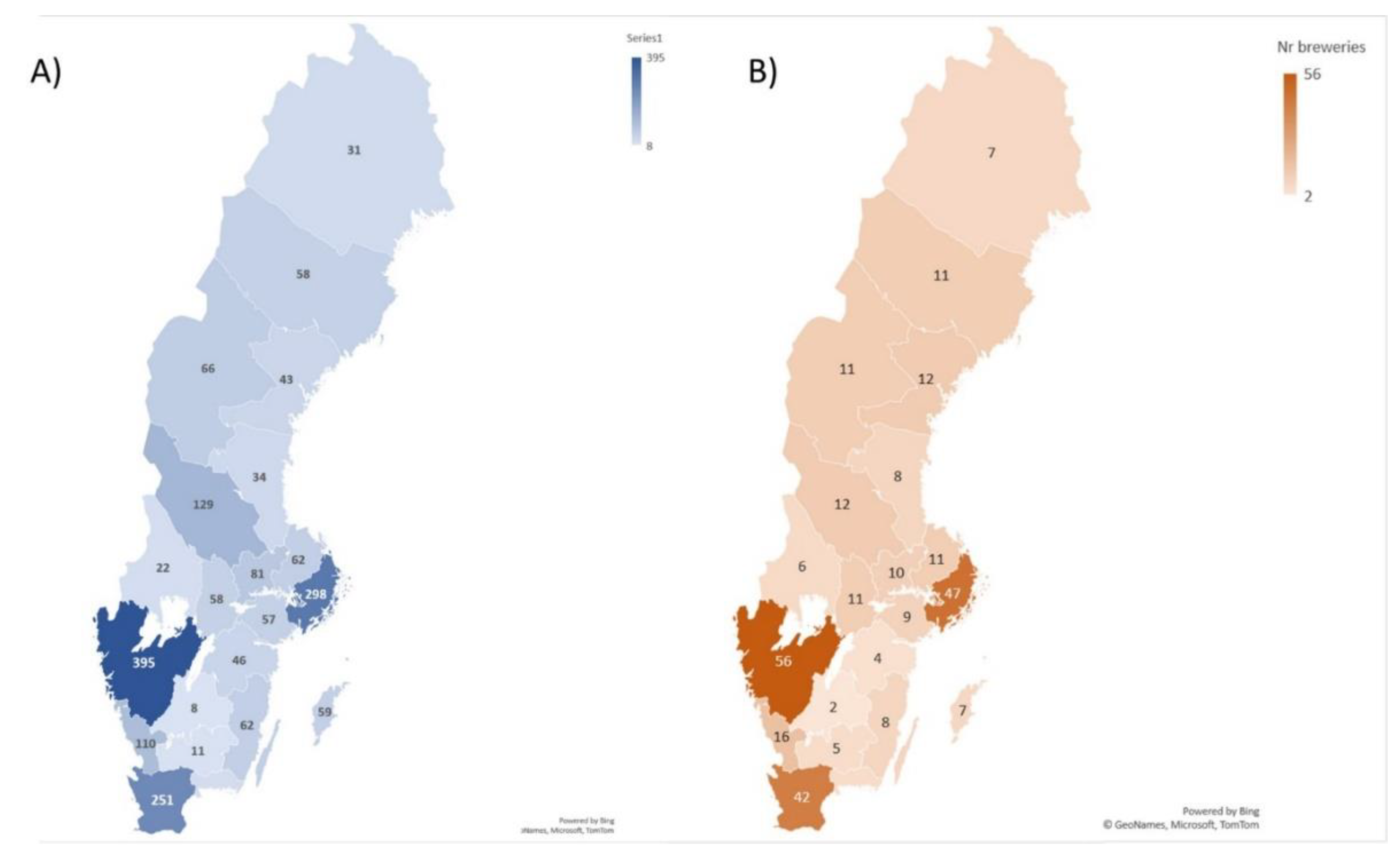

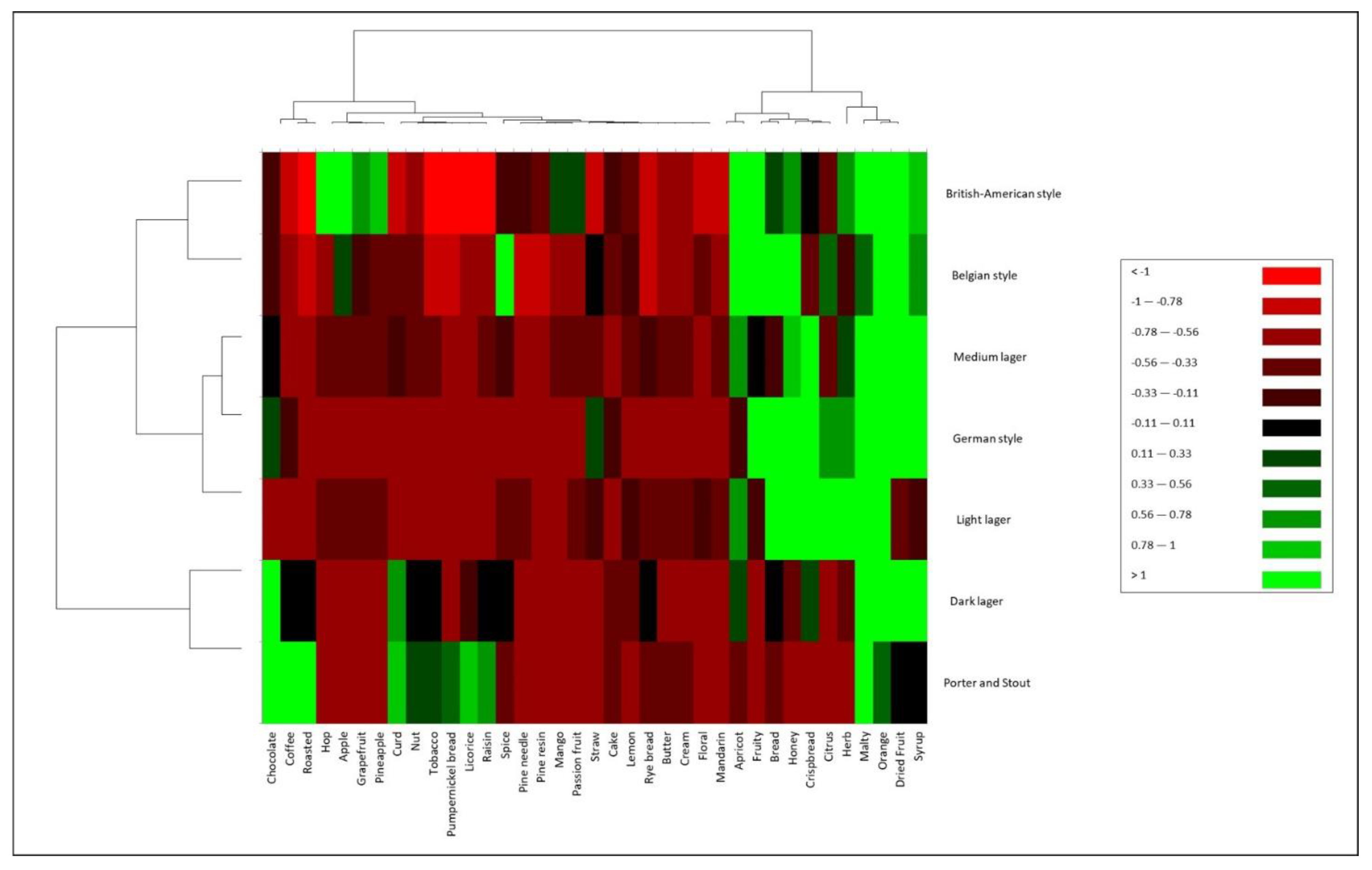
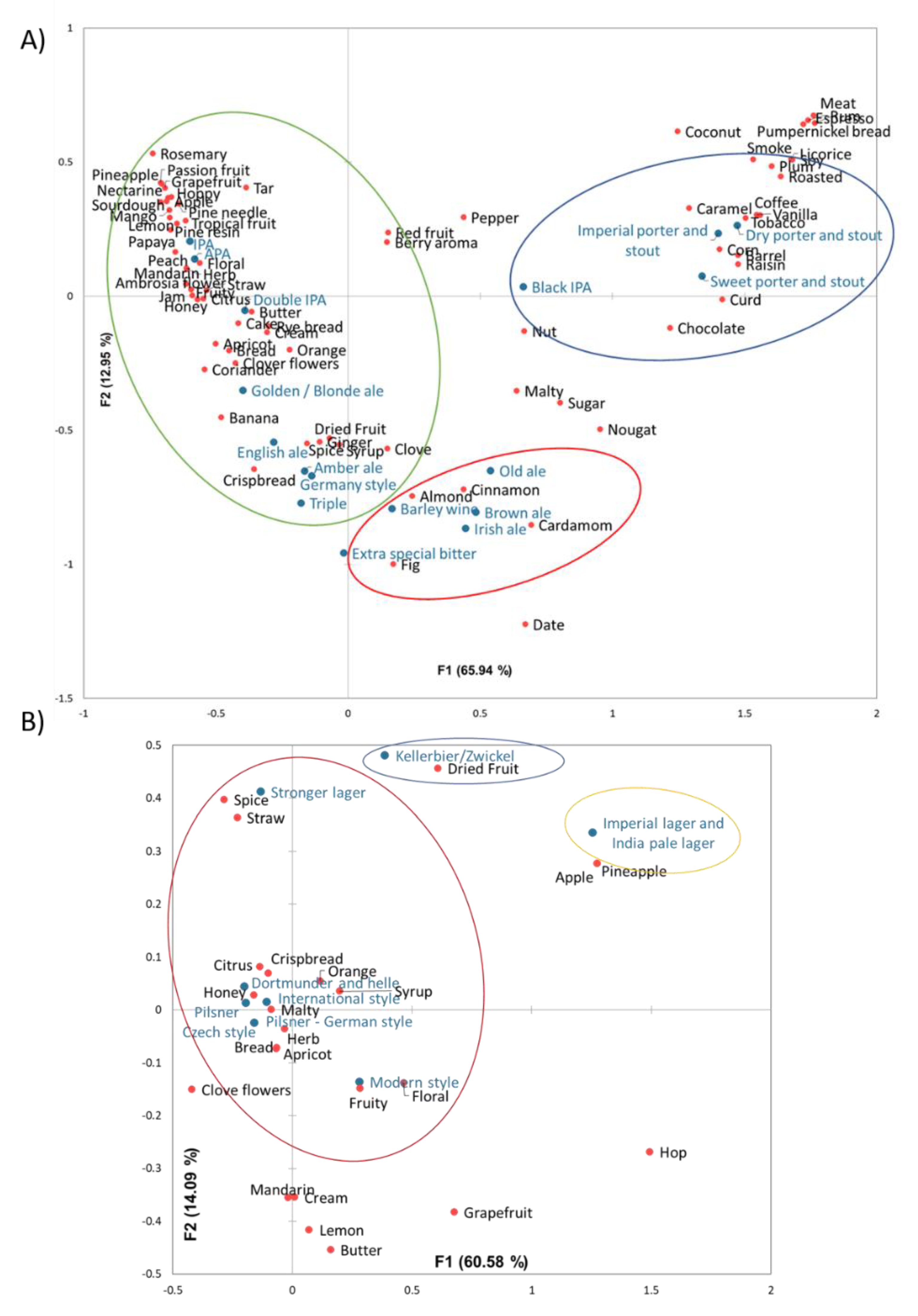
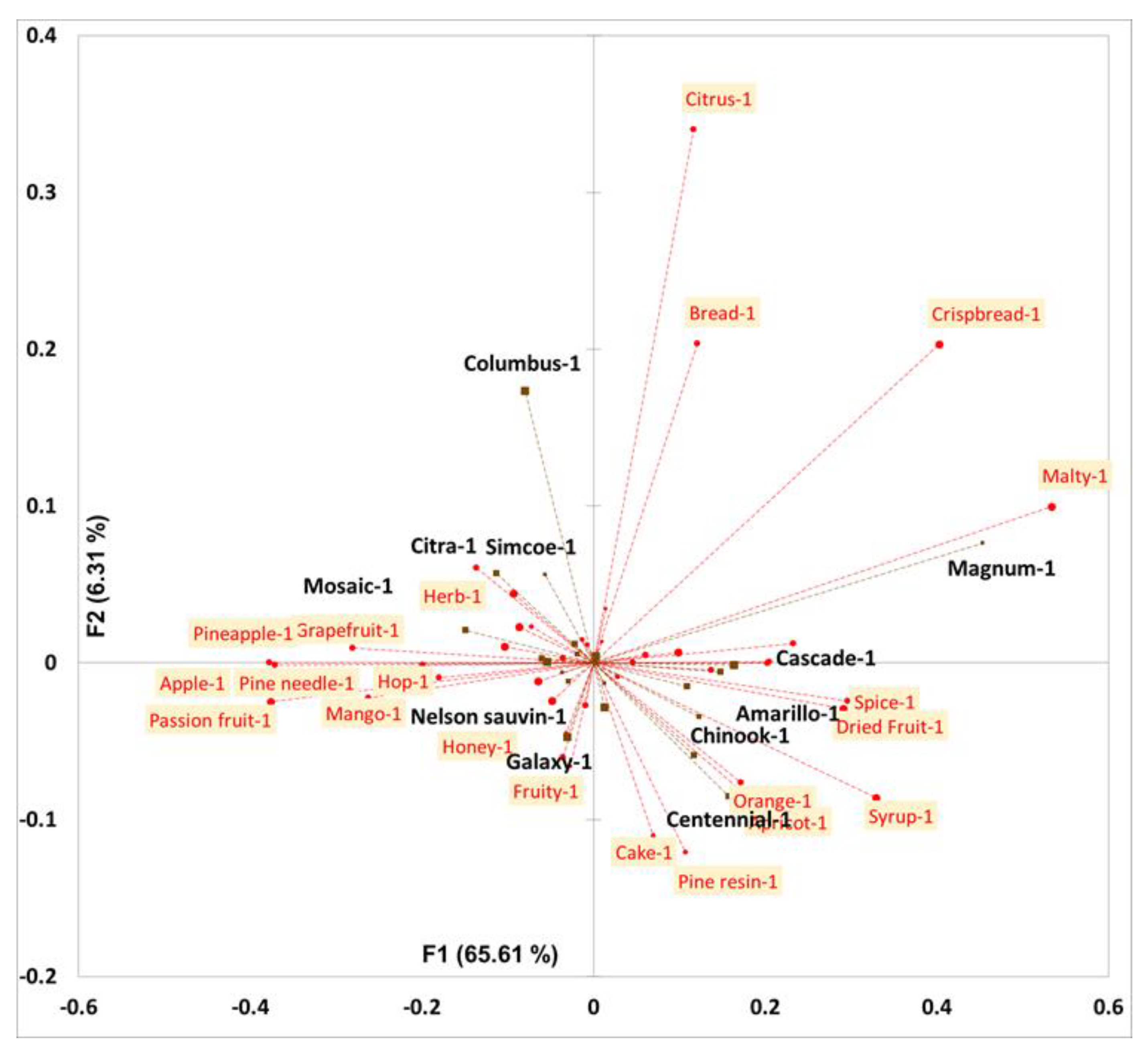
Publisher’s Note: MDPI stays neutral with regard to jurisdictional claims in published maps and institutional affiliations. |
© 2021 by the authors. Licensee MDPI, Basel, Switzerland. This article is an open access article distributed under the terms and conditions of the Creative Commons Attribution (CC BY) license (https://creativecommons.org/licenses/by/4.0/).
Share and Cite
Garrido-Bañuelos, G.; de Barros Alves, H.; Mihnea, M. Mapping the Sensory Fingerprint of Swedish Beer Market through Text and Data Mining and Multivariate Strategies. Beverages 2021, 7, 74. https://doi.org/10.3390/beverages7040074
Garrido-Bañuelos G, de Barros Alves H, Mihnea M. Mapping the Sensory Fingerprint of Swedish Beer Market through Text and Data Mining and Multivariate Strategies. Beverages. 2021; 7(4):74. https://doi.org/10.3390/beverages7040074
Chicago/Turabian StyleGarrido-Bañuelos, Gonzalo, Helia de Barros Alves, and Mihaela Mihnea. 2021. "Mapping the Sensory Fingerprint of Swedish Beer Market through Text and Data Mining and Multivariate Strategies" Beverages 7, no. 4: 74. https://doi.org/10.3390/beverages7040074
APA StyleGarrido-Bañuelos, G., de Barros Alves, H., & Mihnea, M. (2021). Mapping the Sensory Fingerprint of Swedish Beer Market through Text and Data Mining and Multivariate Strategies. Beverages, 7(4), 74. https://doi.org/10.3390/beverages7040074






